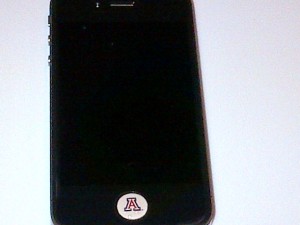Published on
Marketing CE: Branding on an iPhone, iPad and other iDevices

This is because everyone owns a smart device. In the pocket of the vast majority of Americans is a smartphone. And, for 42 percent of that group, their smartphone of choice is Apple’s iPhone.[1] Beyond phones, more and more people are purchasing tablets for personal computing. And, once again, Apple’s iPad dominates with a 32 percent market share.[2]
There are plenty of ways to market to your prospective continuing education (CE) students via iPhones and iPads. But these devices are so ubiquitous. They’re everywhere, figuratively and literally.
So, here’s an obvious question: what about marketing on them? Really, physically, on them so your brand is seen every time the device is touched, not just when the screen is on?
In the past few years, I’ve tried this via two methods; one that didn’t work, and one that appears to be effective.
The Bad
First, the bad. An iPad skin/cover. I wrote about this a while ago, but it’s worth revisiting. This was a sticker that goes on the back of an iPad, along with a border that attaches to the front around the screen. Additionally, a background image of our school logo could be downloaded. We achieved full coverage of the iPad with our school logo; a good thing.
But perhaps it was too much. Current CE students would ask for them (“Hey, cool, an iPad skin!”), but they would ultimately never use them. It was all too much. Too much work to install and too much of our logo on it.
Overt marketing can cross the line, and finding a balance is a challenge.

The second — successful — marketing item is easy and just the right size: a button with the university logo that sticks over the ‘home’ button on an iPhone or iPad.
This is small, easy to install, easy to remove and soft with a nice touch to it. The cost was also right; about 50 cents a button. The vendor provided two in a package so students either had one for each device or one to pass along to a friend, kid or colleague (more exposure!). Students ask for them in class and install them right away. Admittedly, with heavy or abusive use, the buttons can fall off. However, this negative spins easily into a positive. Providing a replacement gives us another chance to engage in an interaction with a student.
Interest in the buttons has been high among students between 18 and 28, and those 50 and over. Fans of the university’s sports teams also ask for buttons, helping expand brand awareness. Hopefully, our current and prospective students pushing the button on the Apple device will ultimately translate into increased enrollment in our CE programs.
– – – –
References
[1] Luke Villapaz, “Apple iPhone Continues to Lead Samsung and Other Android Smartphones in US Mobile Market,” International Business Times, January 16, 2014. Accessed at http://www.ibtimes.com/apple-iphone-continues-lead-samsung-other-android-smartphones-us-mobile-market-graph-1542927
[2] Trefis Team, “Samsung Launches New Premium Tablets, But Going After Apple’s Market Share Could Be a Challenge,” Forbes Magazine, June 17, 2014. Accessed at http://www.forbes.com/sites/greatspeculations/2014/06/17/samsung-launches-new-premium-tablets-but-going-after-apples-market-share-could-be-a-challenge/
Author Perspective: Administrator



